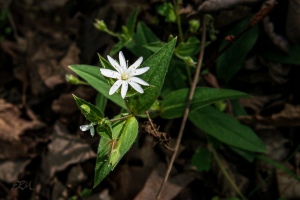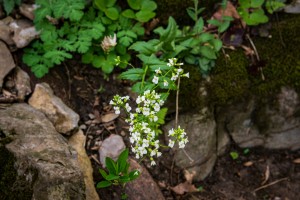
In 1792, when Thomas Jefferson was serving as the US Secretary of State, his botanist friend Benjamin Smith Barton decided that twinleaf must be in a genus of its own, “distinct from the Sanguinaria and the Podophyllum”*, and dubbed it Jeffersonia binata.
Twinleaf now goes by the name Jeffersonia diphylla (Berberidaceae). It isn’t exactly rare, but it isn’t common, either. It ranges from western New York south through the Appalachians to northernmost Alabama, then northwest as far as southeastern Minnesota. In all the states where it’s found, it occurs in only a handful of areas. It’s currently listed as endangered in Georgia and New Jersey, and threatened in Iowa and New York. The Biota of North America Project shows it present in Montgomery County, Maryland, and all counties to the west, but the Maryland Biodiversity project has records for it only in Montgomery, Washington, and Allegany counties.

As I wrote last week, this is a plant whose blossoms last only a few days. I saw two twinleaf flowers on Tuesday. On Thursday, a few more were blooming but were closed up tight because of the overcast. And yesterday, I saw maybe a dozen flowers, most of which were already fading and starting to set seed.
Twinleaf is a delicate-looking plant, consisting of several tall-standing basal leaves, each of which is nearly bisected into mirror image pairs. The leafless flower stem bears a single large, white flower, which has four sepals, eight petals, eight stamens, and one pistil.

The plant itself persists for another month or two past flowering before going dormant.
This is the earliest I’ve seen it blooming in the six years I’ve been tracking it.
*Thomas Jefferson’s Garden Book, 1766 – 1824; Edwin Betts, editor
 [right and below]
[right and below]






















